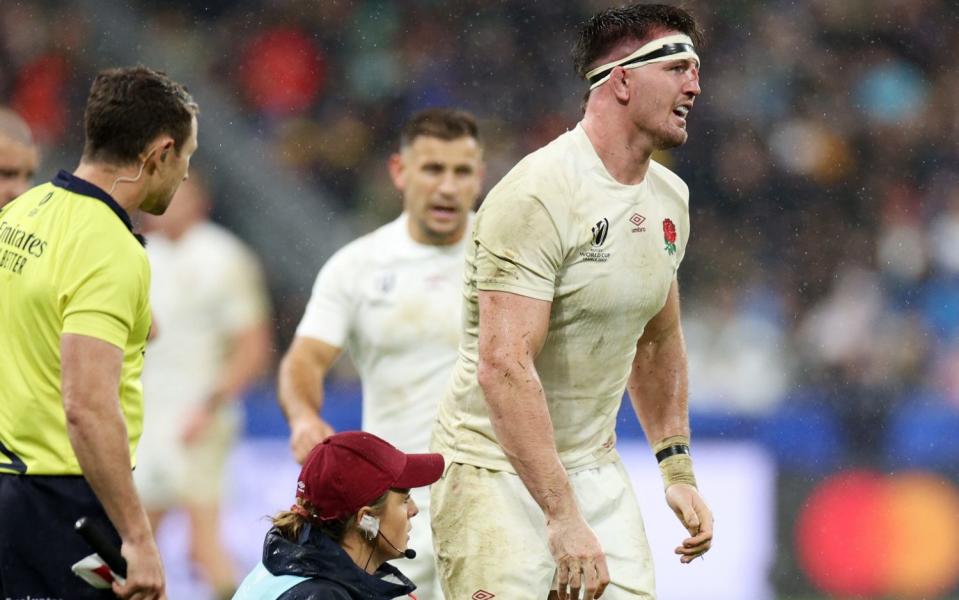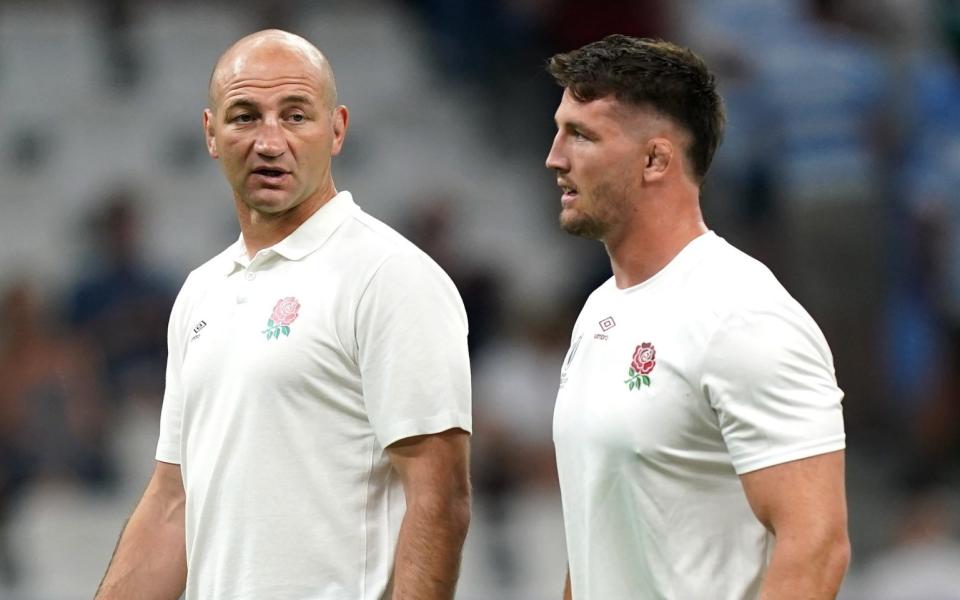Tom Curry: I am not ready to have a metal hip – but I don’t know when I’ll return

Tom Curry has revealed details of the “major” hip injury that required the Sale and England flanker to undergo lengthy surgery to save his career, after rejecting the option of having a metal hip inserted similar to tennis great Andy Murray.
Curry is working his way back to full fitness following a six-hour operation but currently has no planned date to return to the field, having not played since England’s bronze final win at the Rugby World Cup before his operation at the end of November.
Curry has for the first time detailed the devastating extent of an injury which left him needing to relearn how to walk and run, and noted that his playing time had gradually reduced during the end of the World Cup, playing only 49 minutes against Argentina, before the realisation set in that surgery was required.
“We thought it was tight hip flexors, but the time it took to play the games got less and less,” Curry said in an interview with Sharks TV, Sale’s in-house media channel, which will be released on Tuesday.
“I came back and tried to play for Sale and couldn’t really do that so we had it scanned, and found out that there was an arthritic change within the hip; labrum and cartilage tears. The radiologist’s report was a long list, a bit of a car crash. But the surgeon went in and was very happy when we came out which gave me a lot of confidence.”

Curry’s surgery involved reshaping the head of the femur, fixing the labrum tears and sewing them up, before adding some synthetic cartilage and covering it with stem cells. The extensive operation was Curry’s preferred choice out of three possible options.
“One was to leave it; that wasn’t going to happen the way I was walking and running. Two was [the surgery], and then three was the resurfacing where they put the metal in. I wasn’t ready for that, I wanted to keep my hip. The surgery was the best option of the three.”
Murray was 31 when he opted to undergo hip resurfacing surgery back in 2018, after suffering with pain in his joint for a number of years. Curry, who won his 50th cap for England in their final World Cup match last November and has three Test appearances for the British and Irish Lions, is still only 25.
After spending the first two weeks following his operation living downstairs at his parents’ house while he recovered, Curry has since enthusiastically dived into this rehabilitation.
“[The medical staff] wanted me on the bike the day after the surgery. After two to three weeks I was able to start gently rehabbing, loosening the hip up. Honestly, straight away you could feel it. As soon as I was able to move it to the side my hip just kept going. It was a refreshing feeling.
“After the scan, the first few weeks were tough because it was just accepting it. There were a lot of unknowns. You are a bit helpless. You have all this information and you are sat there just waiting. Once the surgery was done, I was flying. You can start getting better and feeling better.”
‘It is about almost teaching yourself to walk again’
Despite those positive developments, Curry added that the reason no deadline had been set for his return was to not apply any extra pressure to an already intricate recovery process, which has included re-learning how to walk and run.
“It has been pretty relaxed,” he said. “In terms of coming back to play, I still don’t really know. It is day by day. If you take a step and your hip feels bad, your mood goes down. If you do that and your hip feels good, your mood goes up.
“So it is about trying to get rid of all that stuff and keeping it as simple as possible.
“The main thing is to start the running mechanics again. We have been focussing on the strength of the muscle but now it is about being able to use that within the range. We have done stretching but it is about almost teaching yourself to run again – even teaching yourself to walk again. Every week it just gets better.”
That has meant that Curry has been a spectator at home watching England start their new World Cup cycle, with the former England captain understandably vexed at being unable to help his country in the Six Nations.
“It’s definitely frustrating, but it gives you a bit of an edge going into your next training session, you have a jump in your step. You have something that you want to go for and, watching England, it gives you that drive to push on and work a bit harder.”
While a return for Curry seems some way off, certainly next season rather than in this campaign, the positive news of his continued progress should come as a boost for both Sale and England supporters despite such a major operation.

Intensity and game time have taken toll on ‘Kamikaze Kid’
By Ben Coles
A few years ago, an England peer of Tom Curry’s wondered whether the flanker could maintain his intensity without needing to retire before the age of 30.
Separately, at the start of the 2019 Rugby World Cup, then England coach Eddie Jones noted the ‘Kamikaze Kid’ flankers Carry and Sam Underhill “just rip and tear. They’ve got no care for their bodies and they lead the way in terms of our defensive effort”.
With that in mind, listening to Curry discuss when he might return to the field, currently an unknown date in the future, may spark two reactions.
Firstly, that his caution regarding his long-term recovery from such a major operation on his hip comes across as eminently sensible. It is a mature approach which should not be a surprise coming from a player who has achieved so much at an incredibly young age, captaining England and serving as a vice-captain while winning a half-century of caps for his country and another three for the British and Irish Lions against South Africa.
There is also a sense of shock that a 25-year-old athlete on the cusp of entering his prime as a top rugby player is having to relearn how to even move his body again.
Curry has always been a tremendous jackaller and relentless tackler, and yet as the Rugby World Cup went on, his minutes on the field decreased, leading him to a major crossroads in his career.
Since his Test debut on the summer tour to Argentina back in 2017, only six of Curry’s team-mates have played more minutes for England (in order): Maro Itoje, Owen Farrell, Jonny May, Elliot Daly, Jamie George and Henry Slade.
It has been less than 18 months since Curry spoke about his mother expressing concern on whether jackalling in rugby was safe.
“It’s rugby and you can’t change it – that’s the sport we love. The only complicated bit is when people start rolling in and pulling around,” Curry said at the time, somewhat forebodingly.
Not only for his own safety but that of his twin brother, Ben, who injured his hamstring after falling victim to a ‘crocodile roll’ at a ruck last May – where a jackalling player is effectively rolled to the side by a clearout – which ruled him out of the Gallagher Premiership final for Sale.
It remains an area which must be addressed and the severity of Tom’s injury should ring alarm bells.
The two Currys will always be compared given they are twins playing in the back-row, with Ben playing in more games (154 to 146) but Tom playing more minutes (9,112 to 8,715).
Tom has of course played in far more Test matches, in which the level of physicality is notoriously more severe than the club game.


